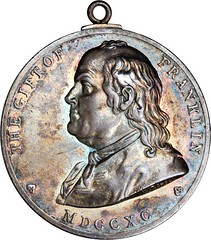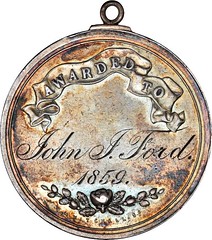
PREV ARTICLE
NEXT ARTICLE
FULL ISSUE
PREV FULL ISSUE
V25 2022 INDEX E-SYLUM ARCHIVE VOCABULARY TERM: MEDAL AWARD PROGRAMHere's another entry from Dick Johnson's Encyclopedia of Coin and Medal Terminology. Well written. I added an image from an earlier E-Sylum article. -Editor Medal Award Program. A plan for the administration of the bestowal of medals for some beneficial purpose to mankind or some field of endeavor. Such a plan includes how often the medal will be awarded, the criteria for selection of the recipients and the ceremony for the presentation. Often a fund is established (occasionally specified in a will) for the long-range bestowal of the medal on a periodic basis. The medal frequently takes on a memorial to either the benefactor or to some notable person in the field who is often chosen to be portrayed on the medal. Depending upon the amount of funds in the endowment, quite elaborate and handsome medals can be created, (designed and sculpted by prominent sculptors) or, if the funds are sparse, a stock design is chosen from the inventory of the medalmaker and customized only by adding the name of the award and the sponsor. This class of numismatic items, called award medals, serve the purpose of recognizing talent or achievement in some field of human activity. The most famous of these award medals in existence – Nobel, Carnegie, Pulitzer, Caldecott, Newberry, Peabody – are known throughout the world and promote scientific, medical, literary or beneficial achievements such as lifesaving or peace. In contrast to these famous medals are the thousands of medal programs known only within their immediate field. One of the most famous award medals is notable because of its benefactor. The will of Benjamin Franklin left a fund to establishing the Boston School Medal. It was to be awarded to boys (later to include girls, called the City Medal) for scholarship in Boston grade schools. But Franklin's original funds ran out, and the City of Boston assumed the sponsorship ultimately, but retained most of the tenants of Franklin's medal award program. Award medal administration. Managing an award medal program is important. Often this management is undertaken by an organization with little experience. Sometimes, it is administered by a nonprofit organization, but is sponsored or the cost underwritten by a private corporation. See sponsor, sponsorship. The administrators must oversee a board or committee in the selection of recipients, notification of these recipients, ordering the medals, the cases, the engraving, the certificates. Also, and of extreme importance is the award ceremony – often at a dinner – and publicity it generates to the benefit of the organization and the purpose of the award. Award medal factors. There is a large initial cost for the development of a new award medal. This includes design, modeling, and die production. Once the dies are completed then medals need be struck. However with most award medal programs only a few medals are needed each year. Since there is also a substantial cost in setting up the press, it is not cost effective to strike only a medal or two each year. Instead an innovative plan was established to strike, say a ten-year supply and to retain these, either with the administrators or at the medallic company. Once the recipient is known it can be inscribed, finished and fitted with an appropriate case. When most medal award programs are established the factor of rising costs are not taken into consideration. This kills more medal programs, particularly if the medal is made of precious metal, than any other reason. Costs of gold and silver fluctuate. Since most endowments are fixed, this means that gold medals are pure gold at the inception, but dwindle in time. Lesser karat gold is used, then gold filled, then goldplating as the administrators scramble to have the medals produced with the limited funds at their disposal. This leads to awarding the medal less often, and, ultimately, to abandoning the medal program altogether. Numismatic concerns. Award medals are the contribution numismatics can make to the field of recognizing outstanding human achievement. Medals symbolize this recognition in a personal, permanent and artistic form. It encourages the medals to have a unique and attractive medallic design, to be created by talented, experienced artists.
Cataloging award medals, the function of numismatists, have traditional rules. The medals are dated the year they are awarded (not the year they were made). Thus the medal in general is described:
To read the complete entry on the Newman Numismatic Portal, see:
To read the earlier E-Sylum article, see:
Wayne Homren, Editor The Numismatic Bibliomania Society is a non-profit organization promoting numismatic literature. See our web site at coinbooks.org. To submit items for publication in The E-Sylum, write to the Editor at this address: whomren@gmail.com To subscribe go to: https://my.binhost.com/lists/listinfo/esylum All Rights Reserved. NBS Home Page Contact the NBS webmaster 
|


